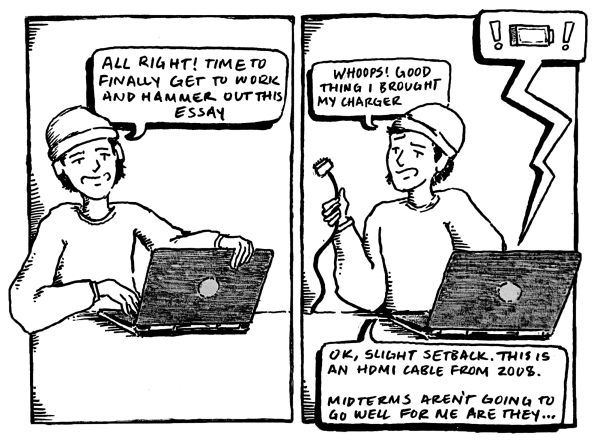Budget Cuts to Libraries Limit Crucial Academic Resources
For about three months now, I’ve been working in the periodicals department of the Mary Church Terrell Main Library, a job which involves checking in and sending out or shelving periodicals for all four of the libraries on campus. As the semester went on, I slowly began to notice a disturbing trend. It started with the barren shelves of Azariah’s Café, not even half-filled with publications. Then came the growing list of journals and magazines for which we were canceling subscriptions. The words “subscription canceled” seemed to pop up on my screen at least once every day. When I talked to my supervisor about these observations, I got to the bottom of what compelled this shift: campus-wide budget reductions.
According to Azariah S. Root Director of Libraries Valerie Hotchkiss, these shifts in funding have been in effect since 2019 as stipulated in the One Oberlin Report produced by the Academic and Administrative Program Review in the same year. “Most units on campus agreed to a 15 percent overall budget reduction,” Hotchkiss wrote in an email. The library isn’t being singled out or targeted with these cutbacks, but it is being significantly impacted. In the same email, Hotchkiss mentioned that “almost 90 percent of [the] acquisitions budget goes to recurring costs,” which include serial subscriptions, databases like JSTOR, and OhioLINK, a resource which facilitates inter-library loans in the state of Ohio. These subscriptions are only increasing in price — rising “at an average of 5-7 percent a year,” per Hotchkiss — meaning that in order to even keep the same diverse and expansive array of materials they already have, university libraries need all the funding they can get.
It is easy to wonder why magazines and periodicals are so important in the first place. Naturally, books and other resources that involve a one-time fee are vital for research and academic enrichment, but with the availability of online subscription services, the breadth and accessibility of information is so much greater. Digital libraries and cooperative consortia allow modern libraries to provide students with so much more than can physically fit in their walls — as Hotchkiss put it, “No library needs to own everything, as long as many libraries work together.”
Because many resources can now be accessed online, students can quickly find and peruse sources for a last-minute essay from their rooms. Even the physical periodicals are easier to access than the library’s books — one can go to Azariah’s Café and browse through the display, rather than trying to find a tome tucked away on some shelf on the third floor. Further, most serial publications are shorter than individual books, instead neatly packaging the information for readers to quickly digest.
The type of information found in periodicals is also fundamentally distinct from a non-recurring publication. Not only is there a myriad of foreign-language publications across all the libraries, which helps reinforce diversity on Oberlin’s campus, but, whether it be a science journal or a copy of The New Yorker, periodicals inherently contain the most recent information, giving students up-to-date knowledge on whichever issue they might need or want to know about.
Even with this in mind, I wouldn’t make the argument that Oberlin’s libraries should be exempt from budget reductions. As mentioned before, the recommendations issued in the One Oberlin Report were an agreed-upon path forward, and it’s not entirely realistic or reasonable to expect all major divisions on campus to adjust to the new budget plan while leaving the library untouched. Hotchkiss mentioned that there were several journals that were used fewer than 10 times per year, so there are instances where canceling subscriptions is advisable and necessary — especially when lack of use leads to diminishing returns.
However, by and large, the College should be less stringent when it comes to regulating the expenditures of its libraries, especially considering that the 44-page One Oberlin Report is peppered with references to “long-term excellence,” and similar language. Surely a healthy, well-stocked library is crucial to such a goal. In the 2021–22 academic year alone, there were 130,573 total JSTOR full-text retrievals, 34,639 total Elsevier ScienceDirect full-text retrievals, and 995 total Early English Books Online full-text retrievals attributed to Oberlin students and faculty, according to Associate Director of Collections and Resource Services Paul Heyde. 1,755 texts were borrowed using OhioLink. It’s more difficult to measure physical periodical use, but in my experience, whenever I go to shelve issues in Azariah’s, there’s always something out of order — a clear sign of use. More popular publications like Time or Rolling Stone must always be tagged to prevent theft. It’s clear that Oberlin students value their access to these resources, which makes it all the more upsetting that this access is being diminished.
The long and short of it is that we need to be more lenient with the acquisitions budget of the library. I refuse to believe that with its billion-dollar endowment, Oberlin has no room for any sort of discretionary expenses. Hotchkiss mentioned in passing that “the lion’s share of these reductions has taken place over two years instead of five,” which suggested to me that the parties responsible for balancing the budget are being even more uncompromising than they need to be, forcing Oberlin’s libraries to make quick decisions about trimming resources or staff. Thus far, our libraries have tried only to throw the nonessential cargo overboard, but with the way things are going, more drastic measures may have to be taken that limit every student and teacher’s access to important information. Oberlin can’t let it come to that.


